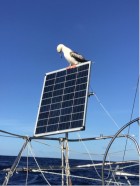L'Eau Commotion Westabout
An (other) attempt to sail non stop Westabout around the world
| Vessel Name: | L'Eau Commotion |
| Vessel Make/Model: | Northshore 38 |
| Hailing Port: | Brisbane Australia |
| Crew: | Bill Hatfield |
25 February 2020 | Scarborough Marina, Brisbane
21 February 2020
21 February 2020 | 59 Miles To Go
20 February 2020 | 114 Miles East Of Australia
19 February 2020 | 220 Miles East Of Gold Coast Seaway
19 February 2020 | 262 Miles To Gold Coast Seaway
18 February 2020 | 304 Miles East Of Gold Coast Seaway
18 February 2020 | 328 Miles To Go
17 February 2020 | 423 Miles To Go
17 February 2020 | 423 Miles To Go
16 February 2020 | 505 Miles East Of The Gold Coast
15 February 2020 | 617 Miles To Go
14 February 2020 | 755 Miles To Go
13 February 2020 | 888 Miles To The Gold Coast
12 February 2020 | 1032 Miles To The Gold Coast
11 February 2020 | 580 Miles North Of The Waikato
11 February 2020 | 1167 Miles To Home
10 February 2020 | 1300 Miles To Home
10 February 2020 | 1309 Miles To The Gold Coast
09 February 2020 | 1460 Miles To The Gold Coast Seaway
Recent Blog Posts
20 February 2020 | 114 Miles East Of Australia
ETA Looking Likely
Day 258 6am Friday 21st February 2020
19 February 2020 | 220 Miles East Of Gold Coast Seaway
Amended ETA
Day 257 6am Thursday 20th February 2020
19 February 2020 | 262 Miles To Gold Coast Seaway
Amended ETA
Day 256 10:30pm Wednesday 19th February 2020 ( UTC+10 )
Gybing The BiSymmetric*
11 July 2019 | 630 Miles West of Shark Bay, West Australia
Day 34 8pm Thursday 11th July 2019
The great advantage of the BiSymmetric* is that it is very stable but does have the complication that there are many sheets and lines that must be attended to. By easing the sheets a little at a time it is quite easy to furl the sail with a small winch and it's continuous line. The pole can then be dipped, disconnected from the mast and passed to Starboard while re running the down haul and feeding the windward sheet. The main is then gybed and its preventer, running from the bow, is switched to the leeward side of the boom and the lee sheet of the twin is fed through a block on the end of the boom down to a block on the main track and back to the main winch. Both headsail sheets are then taken in as the furler is released in stages and the sail then filled and trimmed. Though a little complicated this ensures that the main boom is always under control and in no danger of an unexpected gibe with the extra problem of it being swept along by the headsail; further the BiSymmetric* being quite large at 80 square metres has limited opportunities to tear or snarl. Even though this is only day two of its use the extra speed and comfort is really appreciated - we have averaged over seven knots in an often quite light following breeze.
* (attrib W.H. 1939- )
The great advantage of the BiSymmetric* is that it is very stable but does have the complication that there are many sheets and lines that must be attended to. By easing the sheets a little at a time it is quite easy to furl the sail with a small winch and it's continuous line. The pole can then be dipped, disconnected from the mast and passed to Starboard while re running the down haul and feeding the windward sheet. The main is then gybed and its preventer, running from the bow, is switched to the leeward side of the boom and the lee sheet of the twin is fed through a block on the end of the boom down to a block on the main track and back to the main winch. Both headsail sheets are then taken in as the furler is released in stages and the sail then filled and trimmed. Though a little complicated this ensures that the main boom is always under control and in no danger of an unexpected gibe with the extra problem of it being swept along by the headsail; further the BiSymmetric* being quite large at 80 square metres has limited opportunities to tear or snarl. Even though this is only day two of its use the extra speed and comfort is really appreciated - we have averaged over seven knots in an often quite light following breeze.
* (attrib W.H. 1939- )
Comments


